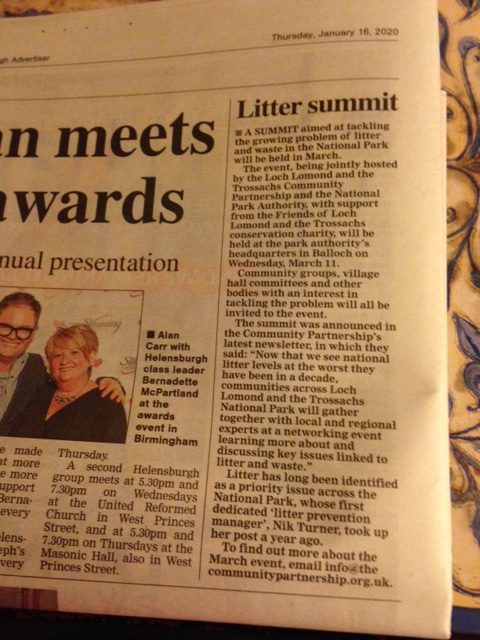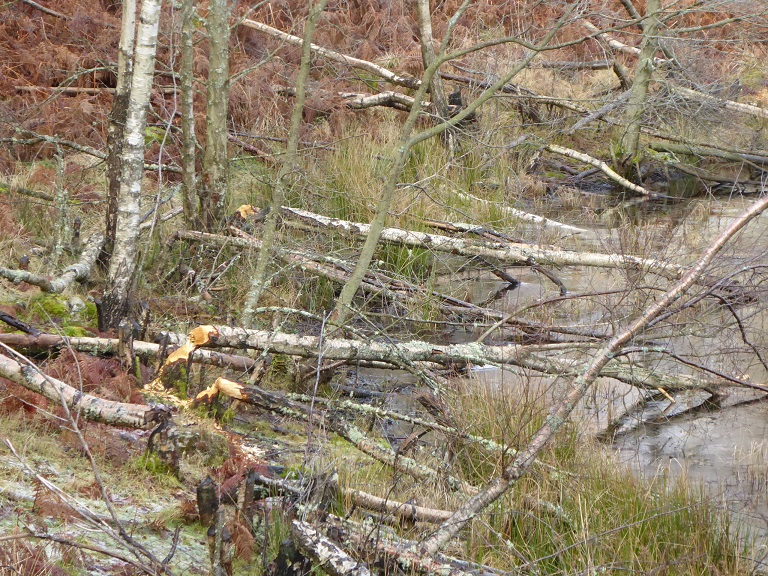
Three years AFTER the introduction of the camping byelaws, its been revealed that there is a “growing problem of litter and waste in the National Park”.
Remember all those photos of abandoned tents left by campers who were blamed for the litter problems in the National Park and which were used to justify the introduction of the camping byelaws? If not, here is a wee reminder from the Loch Lomond and Trossachs National Park Authority’s news release announcing the byelaws:

So what’s causing all the litter now? Have campers simply ignored the camping byelaws or does the growing problem of litter and waste have other causes?
According to the LLTNPA’s Annual Update on the Camping Byelaws for Scottish Ministers (see here), which was considered at their December Board Meeting, the camping byelaws are working, but not very well:
“Key challenges and areas for improvement in relation to camping management moving forward include further reductions in inappropriate toileting, littering and irresponsible use of fires across the National Park in specific areas where these problems persist”
So, according to the LLTNPA, litter associated with campers has reduced even if “problems persist” in certain areas. If this is true, what this means is that litter and waste problems caused by OTHERS must have significantly increased!
The truth is that campers have NEVER been the main source of litter and waste in the National Park. Issues like waste abandoned by developers, often with the LLTNPA’s cognizance (see here), fly-tipping (see here), litter left at laybys without bins and litter thrown out of car windows (see here) have always been far greater problems.
There were of course issues with a small minority of campers abandoning tents, but this always was a small issue which the LLTNPA deliberately magnified by publishing hundreds of photos of the same abandoned campsite from different angles. The camping byelaws haven’t stopped those problems as is demonstrated by this news release (see here) from October, in which the LLTNPA urges:
“For camping trips and other outdoor pursuits, invest in tents and other gear that can be used over and over again, rather than leaving valuable materials in our natural environment. Leaving tents and other items behind is flytipping and you could be fined.”

I came across another good illustration of how the LLTNPA deliberately misled the public about the environmental impacts of irresponsible campers at the weekend:

Photos of trees chopped by a small minority of campers were, like abandoned tents, used by the LLTNPA to justify the camping byelaws. (The byelaws created a new additional criminal offence of collecting or using wood that might cause damage). The byelaws have, just like litter, NOT stopped the occasional chopping of trees by campers but this damage rather pales into insignificance compared to what beavers are doing on Tayside and which conservationists generally agree is good for the natural environment (see here)!
No wonder the LLTNPA is not keen to promote and protect the beavers which have snucked into the National Park over the last couple of years. Their presence will soon put the occasional “damage” caused by campers into perspective……….
What needs to happen
The announcement of a litter summit in March is an indication that the LLTNPA’s litter prevention manager, Nik Turner, is doing a good job and is now trying to get the Park to address the real causes of litter rather than blame campers for everything. That is welcome, even if the LLTNPA’s focus still appears to be on litter left by visitors rather than those travelling through (stuff chucked out of car windows is almost certainly the biggest source of litter in the National Park), or fly tipping or indeed waste left in the countryside by some landowners.
With the litter problem increasing, there is no now excuse for the LLTNPA to continue with the camping byelaws, which have been both ineffective and very expensive to enforce. Instead they should redeploy the resources wasted on trying to ban and control campers on installing basic infrastructure, such as litter bins in laybys, and employ people to clear up the litter that blights so much of the National Park. I suspect those litter pickers would spend less than 5% of their time on clearing up litter left by campers.
Unfortunately, I don’t expect the LLTNPA to address these issues in their 3 year review of the camping byelaws which their Board is due to consider in March. Their Chief Executive, Gordon Watson, has for a couple of years now been taking every opportunity to tell people that the byelaws are here to stay. Moreover, the “review” will take place after this year’s camping byelaw “season” has started – a clear sign that it was never intended to change anything. Litter, chopped trees, fires, human excrement and the numbers of campers, all have only ever been an excuse to get people who were doing no harm off the land and to remove their access rights (see here for example for what happened by Linda Mackay, the former Park Convener’s house at Loch Venachar).
The camping byelaws have always, at heart, been a civil liberties issue where the behaviour of a few have been used to justify the removal the rights of the many. Its pertinent to ask how far the example of the LLTNPA, and its manipulative consultation four years ago, has now inspired Boris Johnson’s government to consult on new laws to criminalise access in England? The fine piece on this last week by George Monbiot (see here) concludes with the following words:
“History shows that attacks on general freedoms often begin with an attack on the freedom of a minority. It teaches us that we should never allow a government to divide and rule. An attack on one is an attack on all.”
Just a shame that Monbiot seems unaware of how the LLTNPA’s camping byelaws were used to divide and rule and now are being used to try and justify attempts to further restrict access rights in Scotland (see here). The difference between the Scottish and UK Governments is sometimes not as great as is commonly understood…………..

Few SNP politicians seem to realise that, by using camping byelaws in Scotland they are introducing a regulatory form of access as found in England. Neither do they realise this retrograde step has its origins in the attitudes of the Forestry Commission, a UK body until it was fully devolved in April 2019. Before then, too many FC staff refused to accept the principles of the Land Reform (Scotland) Act 2003 and were very opposed to the abolition of byelaws on FC land which was a consequence of the 2003 Act. So, when LLTNP staff were pressing for camping facilities to be introduced along the east shore of Loch Lomond on FC land at Sallochy, correcting decades of neglect by the FC, the FC saw this as an opportunity to restore an England type regulatory access regime. The LLTNP were forced to accept that there would be no cooperation over facility installation unless camping byelaws were also introduced, establishing a little bit of England along the bonnie banks. At that time the Park was led by Mike Cantley (convener) and Fiona Logan (CEO). Firm assurances were given by the Park that such byelaws were a TEMPORARY measure that would ONLY apply to this area of the Park and it was anticipated that they would be removed after 3 years (in 2014). By the time for removal arrived new people led the Park, Linda Mackay (convenor) and Gordon Watson (CEO), and these people, in alliance with the FC led a campaign to not only extend these camping byelaws across much of the rest of the Park, near roadsides, but to extend even further across the whole of Scotland. This Scotland -wide campaign failed when the Land Reform Review Group realised that it was inappropriate for Scotland to adopt an England – type solution to deal with camping. SNP politicians who now want to help resolve problems in the LLTNP would be best advised to abolish the current Board structure and return all the national park powers to the constituent local authorities, ensuring much better cooperation with outdoor recreation interests and far better value for money in the expenditure of Scottish Government resources in this national park.
Time for government intervention on the LLTNPA and a proper investigations into the management of this group of people
Who are deliberately miss leading the public
I see LLTNPA are looking for money for yet another new patrol boat. (Has the electric thing ever been used?)
Every time I take my sailing boat on Loch Lomond one of these things appears and rangers in their dark uniforms stare at me through powerful binoculars. I find this really oppressive, particularly as the only other time I have been scrutinised like this was on the old Inner German Border before it came down. I suppose the rangers are too young to realise what they look like.
If you don’t look like a ned you get loads of attention from them on shore so that they can tick their “customer interaction” boxes because they think you won’t tell them to get lost. I’m fed up getting PC lectures from spotty youths about the loch I was boating on before they were born.
They are also ineffective, all that has changed is that the neds don’t emerge until the rangers have knocked off and gone home. When I complained about some issues at Inveruglas a couple of years ago one of the rangers told me they rarely venture north of the islands.
Nice to see that others have identified that all the pictures of rubbish etc they use for their propaganda come from the same very small set taken years ago.
Litter and waste summit. I contacted the email address given in the last paragraph for further information. I got a very polite reply stating that the event is by in citation only to community interest groups, development trusts and Community Councils in the Llttnpa. I think that says it all about the promotion of Inclusion so much to the forefront of the new Outdoor Recreation Plan which is out for consultation at the moment.
So the public are denied access. Yet some “authority” figure is determining who may be admitted to this private event in our National Park. The consequences of the manner in which the agenda presented for consideration are of international significance. The name list of “local and regional experts” who it is claimed may be on the guest list, should be open to full public scrutiny and available for later discussion. When affiliation to some “Local committee” or transient pressure campaign is sole criteria for admission these individuals are accountable. Unnamed “experts” are accountable to no one. By determining who may attend this “private ” meeting, a distinct agenda is set. ‘Closed shop’ and anonymity of “guests” hardly commends this Park Board whose previous policy failings are under such obvious public scrutiny. ?
Who are these local and regional experts ? How many are invited.? Numbers and names please.
The politicians go on about mental health and wellbeing then stop people who have never left a mess while camping because of people who do make a mess. It is common knowledge that being outdoors is good for you so why would anyone want to stop people enjoying the loch sides and camping ,they must all be nazis
The only substantial area of Scotland to which the public do not have free access by law is one of the National Parks. You couldn’t make it up. Even in the bits that aren’t covered by the camping ban. the Park Authority is responsible for Access not the relevant councils as is the case everywhere else so they are their own judge and jury.